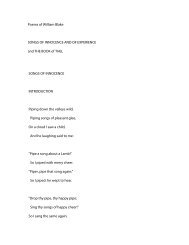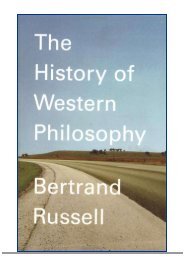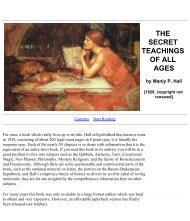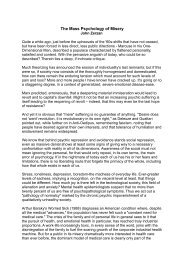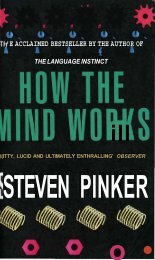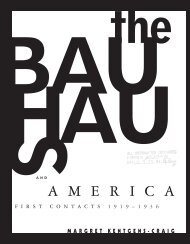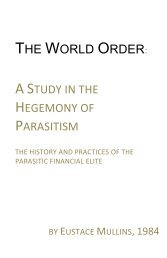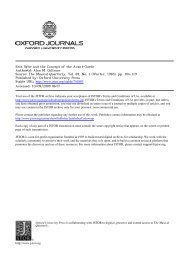discovery of Augustine's words. "I admit I was overcome withwonderment," he continues; "I begged my Brother who also desired toread the Passage not to disturb me, and closed the book. I was irritated forhaving turned my thoughts to mundane matters at such a moment, foreven the Pagan philosophers should have long since taught me that thereis nothing more wondrous than the soul [nihilpraeteranimumessemirabile],and that compared to its greatness nothing is great."Pausing for a new Paragraph, he continues with these surprising words:"My gaze, fully satisfied by contemplating the mountain [i.e., only after aconscious and exhaustive survey of the Panorama], my eyes turnedinward [in me ipsuminterioresoculosreflexi]; and then we fell silent . . "Although obscured by psychological reservations and the memory of hisphysical exertion, the concluding lines of his letter suggest an ultimateaffirmation of his ascent and the attendant experience: "So muchperspiration and effort just to bring the body a little closer to heaven; thesoul, when approaching God. must be similarly terrified.”<strong>The</strong> struggle initiated by his internalization of space into his soul - or, ifyou will, the externalization of space out of his soul - continued in Petrarchfrom that day on MountVentoux until the end of his life. <strong>The</strong> old worldwhere only the soul is wonderful and worthy of contemplation, asexpressed succinctly in Augustine's words "Time resides in the soul," nowbegins to collapse. <strong>The</strong>re is a gradual but increasingly evident shift fromtime to space until the soul wastes away in the materialism of thenineteenth century, a loss obvious to most people today that only themost recent generations have begun to counter in new ways.<strong>The</strong> transition mirrored in Petrarch's letter of six hundred years ago wasprimarily an unprecedented extension of man's image of the world. <strong>The</strong>event that Petrarch describes in almost prophetic terms as "certainly ofbenefit to himself and many others" inaugurates a new realistic,individualistic, and rational understanding of nature. <strong>The</strong> freer treatmentof space and landscape is already manifest in the work ofAmbrogioLorenzetti and Giotto; but although Giotto's landscape with itshill motifs, for example, is still a predominantly symbolic representation ofUmbrian nature, his treatment represents a decided shift away from theunperspectival world. This shift is continued by his apprentices,FraAngelico and Masolino, and later by Paolo Uccello and the brothersLimbourg (in the Très riches heuresduDuc de Berry), who elaborateperspectival painting with ever greater detail. What Giotto merelyanticipated, namely the establishment of a clear contour of man, is firstachieved by Masaccio. It is a characteristic also expressed in AndreaPisano'sreliefs, particularly in his "Astronomer's relief" on the campanile inFlorence, and notably evident in the works of Donatello. We must alsoremember Lorenzo Ghiberti, whose early Bronze relief, the "Sacrifice ofIsaac"(1401-02),is a remarkably authentic rendering of free, open, andunenclosed space. To the extent that a relief is able to convey spatiality,this relief depicts a space where neither the transcendental goldillumination nor its complement, the darkness of the all-encompassing16
cavern, are present but rather one where man is able to breath freely.All of these manifestations arose as genuine artistic expressions anddirect, that is, unreflected utterances of the change in man's attitudetoward the world. Not until the third decade of the fifteenth century didEuropean man begin to reflect and theorize, that is, consciously come toterms with the possibilities and expressive forms of the new style.<strong>The</strong> intent of our somewhat detailed outline of the history of perspective isto indicate the length of time and the intensity of effort that man requiredto fully express internal predispositions in externalized forms. An equallydetailed description of such specific factors will be required further on inour discussion if we are to apply criteria to the inquiry of our own timesthat will permit a valid or, at the very least, a considered judgement.In the third decade of the fifteenth century, CenninoCennini wrote hiscelebrated Trattatadellapittura, the first theoretical treatise an art. <strong>The</strong>various investigations that had preceded his work, notably those by thefriars of MountAthos, Heraclius and <strong>The</strong>ophilus, had been mereformularies. But Cennini, proceeding from a defense of Giotto's style,offers advice on techniques, suggestions for differentiating man fromspace, and instructions an rendering mountains and space by the use ofgradations and shadings of color, thereby anticipating in principle the"aerial and colorperspectivity" of Leonardo da Vinci.About the same time, the brothers van Eyck began to bring increasingclarity and force to the perspectival technique of their painting, while aplethora of attempts at perspective by various other masters points up theneed for spatializationon the one hand, and the difficulty of rendering it onthe other. Numerous works by these frequently overlooked minor mastersbear witness to the unprecedented inner struggle that occurred in artistsof that generation of the fifteenth century during their attempts to masterspace. <strong>The</strong>ir struggle is apparent from the perplexed and chaotic venturesinto a perspectival technique which are replete with reversed, truncated,or partial perspective and other unsuccessful experiments. Such examplesby the minor masters offer a trenchant example of the decisive processmanifest by an increased spatial awareness: the artist's inner compulsionto render space — which is only incompletely grasped and only graduallyemerges out of his soul toward awareness and clear objectivation — andhis tenacity in the face of this problem because, however dimly, he hasalready perceived space.This overwhelming new discovery and encounter, this elemental irruptionof the third dimension and transformation of Euclidean plane surfaces, isso disorienting that it at first brought about an inflation and inundation byspace. This is clearly evident in the numerous experimentalrepresentations of perspective. We will have occasion to note a parallelconfusion and disorder in the painting of the period alter1800when weconsider the new dimension of emergent consciousness in our own day.But whereas the preoccupation of the Early Renaissance was with the17
- Page 5 and 6: deficient forms which have become a
- Page 7 and 8: they could not reach their intent w
- Page 9 and 10: identity, or with his being equated
- Page 11 and 12: was especially influential on Greek
- Page 13 and 14: anticipated by Pope Sabinus, who in
- Page 18 and 19: concretion of space, our epoch is c
- Page 20 and 21: While plumbing the hidden depths of
- Page 22 and 23: With Leonardo the perspectival mean
- Page 24 and 25: perspective, had become common prop
- Page 26 and 27: not an avenue. Although man's horiz
- Page 28 and 29: order to obtain a sequential view o
- Page 30 and 31: the truly unrepresentable become ev
- Page 32 and 33: apparent in the development of aper
- Page 34 and 35: characteristics of the structures,
- Page 36 and 37: Structureaugmentation, a loss or a
- Page 38 and 39: "silenced music" of which St. John
- Page 40 and 41: meantime the integral perception an
- Page 42 and 43: homogeneity of the viscera, as well
- Page 44 and 45: Archaic — OriginaryMagicempathy a
- Page 46 and 47: IntegralCreed)Method(Divinity)(Eteo
- Page 48 and 49: that structure itself. Orestes' act
- Page 50 and 51: in its silent meaning, for he dedic
- Page 52 and 53: directed way, and to a mythical dem
- Page 54 and 55: Even though we may be unable to do
- Page 56 and 57: of arational possibilities which ar
- Page 58 and 59: chapters 5, 6, and 7, we would like
- Page 60 and 61: presupposes in any event the mental
- Page 62 and 63: capability is being formed in him w
- Page 64 and 65: At the moment when consciousness be
- Page 66 and 67:
temporal aspects enumerated. We are
- Page 68 and 69:
understanding the phenomenon of tim
- Page 70 and 71:
temporal forms which co-constitute
- Page 72 and 73:
crystallizing in a new perception o
- Page 74 and 75:
dream-like and somnolent aspects an
- Page 76 and 77:
ealization now manifesting itself a



